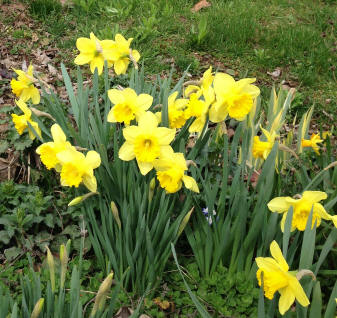 It’s not uncommon for gardeners to find themselves enjoying the beauties of one gardening season while anticipating the chores and expectations of another. Take spring’s flowering bulbs, for example. As we enjoy the profusion of early flowering spring bulbs, it’s not too early to
find ourselves assessing their vigor and deciding if we should plant new bulbs in the upcoming fall.
It’s not uncommon for gardeners to find themselves enjoying the beauties of one gardening season while anticipating the chores and expectations of another. Take spring’s flowering bulbs, for example. As we enjoy the profusion of early flowering spring bulbs, it’s not too early to
find ourselves assessing their vigor and deciding if we should plant new bulbs in the upcoming fall.
If bulb flowers are smaller than they used to be, if their stems are shorter or their flowers are fewer than in the past, it might be time to think about renovating them. If bulbs are sending up nothing but abundant green foliage where before there had been beautiful spring flowers, the bulbs may have become overcrowded. Daffodils and other bulb flowers will not flower
if they become overcrowded.
For the most part, flower production in bulbs does not get better with age. If you are planning to plant new bulbs in the fall, you should take steps now to dig out and discard existing bulbs before the leaf foliage disappears later in the spring. Otherwise, after the foliage is gone, they will be almost impossible to locate and dig up.
Once the foliage is gone, there is plenty of time to decide what and where to plant new bulbs in the fall. You can put some unobtrusive stakes in the ground outlining an area for a new bulb planting and fill that area with annual flowering plants to be enjoyed all summer long. Later in the gardening year after the annuals have been hit by frost and cleared away, there
will be a clean slate to start a new bulb planting. If there are some existing bulbs in the area that you wish to keep, mark them clearly with colored stakes before foliage dies down so you don’t disturb them when planting new bulbs.
Another way of increasing flower bulbs is to divide existing bulbs in the late spring. Dig them up after blooming and before foliage has completely disappeared. Discard any existing bulbs that look shriveled or damaged. Remove very small bulbs and plant them in a separate area to grow into larger ones. Store bulbs that will be replanted in the fall in an open, airy,
dark area through the summer and replant them.
For bulbs that are left in the ground, remove the flowers after they have faded but leave the foliage. This remaining foliage provides the energy for growing bigger bulbs. After the flowers have bloomed, remove the flower stems so the plants put energy into growing bigger bulbs for future transplanting. Always leave the leaves of the bulbs to die back naturally.
Sometimes people cut the foliage back or fold it over and tie the leaves with rubber bands so they don’t ‘look messy,’ but this is not a good idea. The foliage should be left undisturbed to feed the bulbs as they die back.
Anytime bulbs are being planted, it’s always a good idea to add bone meal or one of the readily available bulb fertilizers to the bottom of the hole. Dig the hole about an inch deeper than recommended for the type of bulb, work some bone meal or bulb fertilizer into the soil at the bottom of the hole, cover with about an inch of garden soil and place the bulb on top.
Pack the soil down well as you backfill the soil. If perennial plants are being added in the bulb area, mark the new bulb plantings with stakes so they are not mistakenly damaged when the perennials are planted. I don’t usually water in new bulb plantings; I let the fall rains do that for me.
Feeding established bulbs is also important. In early spring, before the bulbs are flowering, I walk around with a bucket of bulb fertilizer or bone meal and just sprinkle a handful of bone meal or bulb fertilizer on the emerging leaves.
After a drab, cold, rainy winter like we’ve just had, seeing the flowers of spring-flowering bulbs return to the area is particularly gratifying. True gifts of the season that we should considering repaying by managing them carefully to keep them growing long and abundantly for many springs to come.
Read other spring related gardening articles